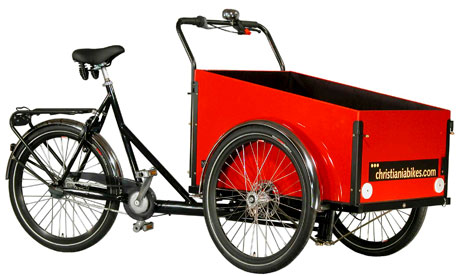From the Guardian.co.uk

Sales of cargo bikes are on the up, and not just in their traditional strongholds of Denmark and the Netherlands. While it is premature to hazard that they might be the next big thing in cycling, there seems at least to be a clear pattern worldwide of increasing numbers of people using them to make jobs traditionally accomplished with a car a little less, well, job-like.
Load moving by bike isn't a new thing, of course. The iconic though ponderous Christiania three-wheeler and its imitators have been getting kids to school and selling steadily since they were first built in the early 1980s; more than half a century before that, their forerunner the Dutch freight trike could reliably get five-a-side team plus subs to training, albeit only if you set off about a day ahead of time. More typically, though, the load tended to be pails of milk or sacks of flour.
The Cetma is another style of cargo bike whose origin we can broadly trace back to the Danish Long John of the 1920s. It seemed it had gone the way of the Dutch trike, but has now been rediscovered by the mainstream after decades in the wilderness. Manouvering one on your first ride feels funny for 10 minutes or so, on account of the yard and a half's distance between you and the front wheel that you're causing to turn from way back there in the saddle. But once you've adjusted, you're pretty much good to go.
The Dutch trike ceased to be widely used because, in comparison with anything motorised, it was too heavy, too strenuous and too slow. But car-clogged streets and common sense are causing conventional wisdom to tilt markedly back towards a school of thought which says, from a work aspect, that if something which needs moving in the city can be plausibly moved by a cyclist, then it probably should be. But the trick is getting people to want to do so.
Because here's an odd thing about cargo bikes. You get one as a means to having the potential to move bulky or heavy loads between A and B under your own steam. But whether you wind up using it with any sort of regularity can often depend almost entirely on how you feel about the way it rides "empty".
In order for your cargo bike to even stand a chance of becoming your default bike, it needs to be an attractive riding option – that means it must be relatively light. Sadly, most two-wheeled front loader cargo bikes up until a few years ago tended to tip the scales at a tiring 35 kilos, even when empty..
Enter the Bullitt. Conceived a few years back by two Danish frame designers and introduced in 2008, it was the first mass-produced aluminium cargo frame. The fork is necessarily of steel, but it comes in at 20-24 kilos.
These sort of numbers have resulted in people using the bike not only when they have something to carry, but simply to get around. And it's also had the healthy knock-on effect of causing many builders of steel frames to figure out ways of shaving off a pound here or there.
The take-up on Bullitts has been good, it seems. I live in Berlin and bought one late in 2008, taking the city's total to three. Now there are about 50.
Many of these Bullitt owners, I should add, are bike messengers who, frustrated at the continually decreasing amount of work available to them in the form of A4 envelopes and video cassettes, are starting to do deliveries previously left to the car drivers. It's a small step in a good direction. Cargo bike riding for bike messengers also comes with the benefits of extra attention and space from other road users, not to mention dry feet, even after nine hours in pelting rain.
I asked Hans Fogh from Bullitt last week about the current state of the cargo game. He was cagey, but upbeat, telling me without mentioning specific figures that each year in business had seen an improvement.
He told me total worldwide sales of cargo bikes in 2008 were about 10,000, with the two biggest producers, Christiania and Nihola sharing about a third of this figure between them
Mikael Andersen of the blog Copenhagen Cycle Chic reckons Denmark is host to about 5,000 new cargo bikes a year, while the Netherlands has at least half that number. With new makes popping up all over North America, added to the fact that Christiania and Nihola now have US and Australian importers, he finds it difficult to see how total global sales of cargo bikes could not be increasing.
For anybody thinking about joining the trend, a good source of information online is Cargo Bike Cult.
• Gareth Lennon blogs at the Brooks Blog
No comments:
Post a Comment